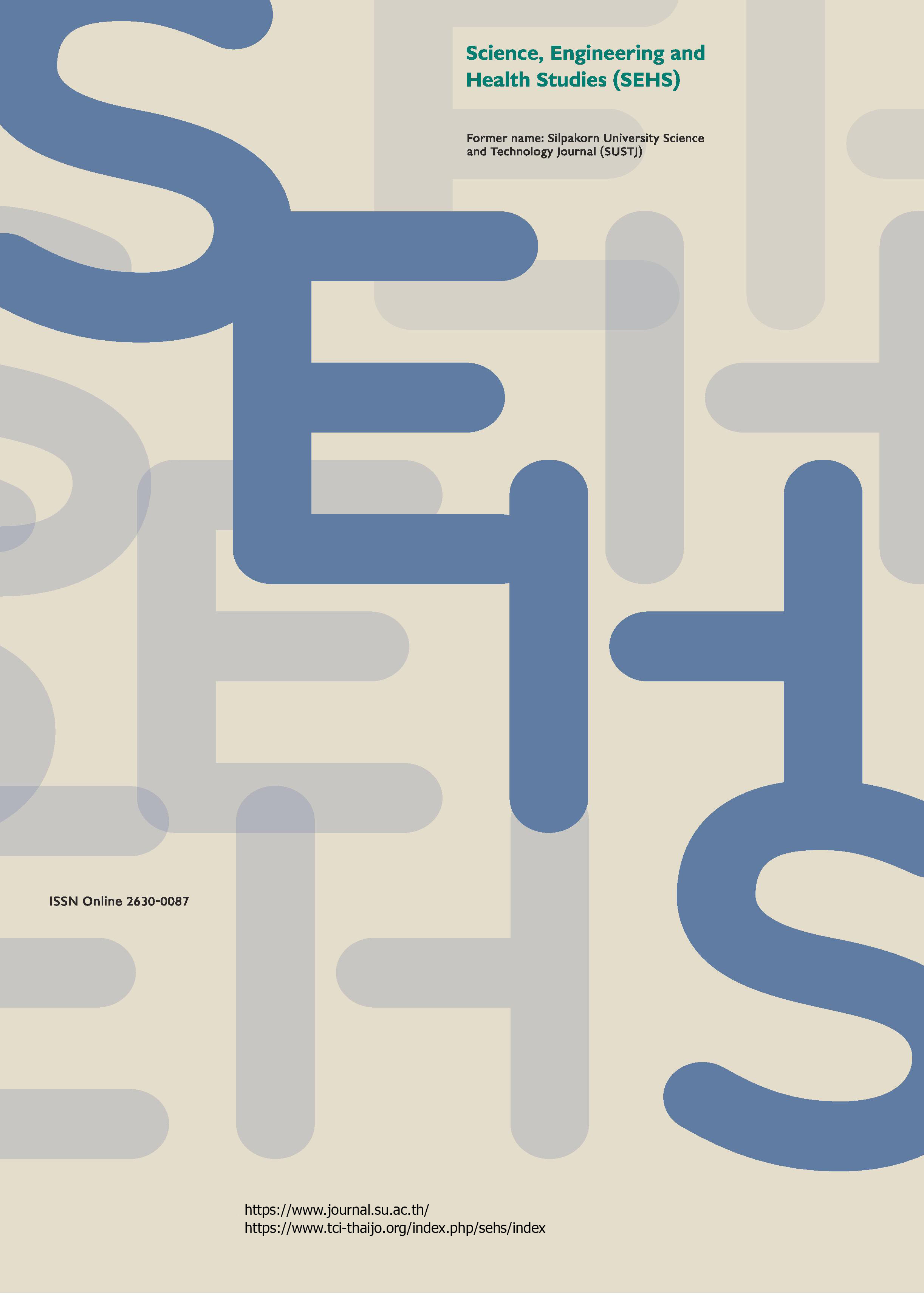Development and simulation of deactivation process of favipiravir in a pharmaceutical wastewater system
Main Article Content
Abstract
Favipiravir (FPV) has been widely used to treat COVID-19 patients in many countries, including Thailand, owing to its potent antiviral activity. Consequently, the wastewater discharged from the formulation process contains a significant amount of active pharmaceutical ingredients that could be harmful to humans and animals if released into the environment without proper treatment. Therefore, this study aimed to develop a deactivation process for FPV present in wastewater using SuperPro Designer Version 10 program. The deactivation processes were classified as two cases: case I (base case) using sodium hypochlorite (NaOCl) at 10% v/v and case II using ozone at 16 g/L. Each case was separated into a subcase A, representing the lack of a filtration unit, and subcase B, representing the use of a filtration unit. The operations used in this study can be characterized as the deactivation unit, neutralization unit, and filtration unit, selected from the equipment available at CRPMF. The simulation results showed that case IIA (with ozone and without filtration) provided the greatest deactivation of FPV per year (65,661 kg/year) but required higher annual investment and operating costs. Meanwhile, case IA (with NaOCl and without filtration) demonstrated an FPV deactivation of 49,243 kg per year, with a cost seven times lower than that of case IIA. In summary, the simulation and cost analysis information were provided to assist CRPMF and other pharmaceutical manufacturers in selecting the scenario that is best suited for the annual capacity of antiviral drug formulation.
Downloads
Article Details

This work is licensed under a Creative Commons Attribution-NonCommercial-NoDerivatives 4.0 International License.
References
Antoniou, M. G., Hey, G., Vega, S. R., Spiliotopoulou, A., Fick, J., Tysklind, M., Jansen, J. L. C., and Andersen, H. R. (2013). Required ozone doses for removing pharmaceuticals from wastewater effluents. Science of the Total Environment, 456–457, 42–49.
Azuma, T., Ishida, M., Hisamatsu, K., Yunoki, A., Otomo, K., Kunitou, M., Shimizu, M., Hosomaru, K., Mikata, S., and Mino, Y. (2017). Fate of new three anti-influenza drugs and one prodrug in the water environment. Chemosphere, 169, 550–557.
Azuma, T., Nakada, N., Yamashita, N., and Tanaka, H. (2013). Mass balance of anti-influenza drugs discharged into the Yodo River system, Japan, under an influenza outbreak. Chemosphere, 93(9), 1672–1677.
Chayliem, J. (2018). Treatment of hospital effluent using ozonation process for water recycle [Master’s thesis, Prince of Songkla University]. PSU Phuket Campus Library. https://opac.phuket.psu.ac.th/BibDetail.aspx?bibno=61270 [in Thai]
Chitniratna, K., and Peungsangarunchai, T. (2021). Development of deactivation plant for favipiravir in pharmaceutical manufacturing facilities [Unpublished undergraduate thesis]. King Mongkut’s University of Technology Thonburi.
Huber, M. M., Canonica, S., Park, G.-Y., and von Gunten, U. (2003). Oxidation of pharmaceuticals during ozonation and advanced oxidation processes. Environmental Science & Technology, 37(5), 1016–1024.
Hussain, M., Mahtab, M. S., and Farooqi, I. H. (2020). The applications of ozone-based advanced oxidation processes for wastewater treatment: A review. Advances in Environmental Research, 9(3), 191–214.
Jarnerud, T., Karasev, A. V., and Jönsson, P. G. (2021). Neutralization of acidic wastewater from a steel plant by using CaO‐containing waste materials from pulp and paper industries. Materials, 14(10), 2653.
Jin, Z., Smith, L. K., Rajwanshi, V. K., Kim, B., and Deval, J. (2013). The ambiguous base-pairing and high substrate efficiency of T-705 (favipiravir) ribofuranosyl 5′-triphosphate towards influenza A virus polymerase. PLoS ONE, 8(7), e68347.
Kermet-Said, H., and Moulai-Mostefa, N. (2015). Optimization of turbidity and COD removal from pharmaceutical wastewater by electrocoagulation. Isotherm modeling and cost analysis. Polish Journal of Environmental Studies, 24(3), 1049–1061.
Ki, D., Kang, S. Y., and Park, K.-M. (2021). Upcycling of wastewater sludge incineration ash as a 3D printing technology resource. Frontiers in Sustainability, 2, 697265.
Lochyński, P., Wiercik, P., Charazińska, S., and Ostrowski, M. (2021). Research on neutralization of wastewater from pickling and electropolishing processes. Archives of Environmental Protection, 47(4), 18–29.
Manabe, T., Kambayashi, D., Akatsu, H., and Kudo, K. (2021). Favipiravir for the treatment of patients with COVID-19: A systematic review and meta-analysis. BMC Infectious Diseases, 21(1), 489.
Morales-Paredes, C. A., Rodríguez-Díaz, J. M., and Boluda-Botella, N. (2022). Pharmaceutical compounds used in the COVID-19 pandemic: A review of their presence in water and treatment techniques for their elimination. Science of the Total Environment, 814, 152691.
Nippes, R. P., Macruz, P. D., da Silva, G. N., and Scaliante, M. H. N. O. (2021). A critical review on environmental presence of pharmaceutical drugs tested for the covid-19 treatment. Process Safety and Environmental Protection, 152, 568–582.
Piemont, A., Coatalem, A., Hinaut, B., Quintela, C., Cazaban, C., Delporte, C., Prevot, C., Gorski, D., Perrin, D., de Jong, E., Sutton-Sharp, E., Toledo, E., Judenne, E., Fenoglio, F., Perrin, F. P., Flores, G., Vanderghote, G., Gorisse, H., Perez, J., … Camy, V. (2021). Liquid Sludge Treatment. [Online URL: https://www.suezwaterhandbook.com/processes-and-technologies/liquid-sludge-treatment] accessed on January 28, 2023.
Singh, R. L., and Singh, R. P. (Eds.). (2019). Introduction. In Advances in Biological Treatment of Industrial Waste Water and Their Recycling for a Sustainable Future, pp. 1–11. Singapore: Springer.
Tulbah, A. S., and Lee, W.-H. (2021). Physicochemical characteristics and in vitro toxicity/anti-sars-cov-2 activity of favipiravir solid lipid nanoparticles. Pharmaceuticals, 14(10), 1059.
Vogna, D., Marotta, R., Napolitano, A., Andreozzi, R., and d’Ischia, M. (2004). Advanced oxidation of the pharmaceutical drug diclofenac with UV/H2O2 and ozone. Water Research, 38(2), 414–422.
Wang, Z. (Ed.). (2010). Heumann indig process. In Comprehensive Organic Name Reactions and Reagents, pp. 1399–1402. Hoboken, NY: John Wiley & Sons.
Zhang, X., Ye, P., and Wu, Y. (2022). Enhanced technology for sewage sludge advanced dewatering from an engineering practice perspective: A review. Journal of Environmental Management, 321, 115938.


